This collection of small and (hopefully) fast loading images
are simply sites and spots that have attracted my attention or
tickled my sense of humour. They are in no particular order,
however this may change over time.
| This photo is taken from the Rex Range lookout on the
road north from where we live heading towards Port
Douglas. The small "double island" (actually
this is its real name as well) is more or less directly
off Clifton Beach / Palm Cove which means we are about 10
kilometres as the crow flies north of home here, but
nearly 20 kilometres by the winding road that clings to
the cliffs. The Rex lookout is used by hang gliders as
the area provides both thermal lift and standing wave
formations that allow them (if they are skilled and lucky
to stay aloft pretty much to the limit of bladder and
sinew. |
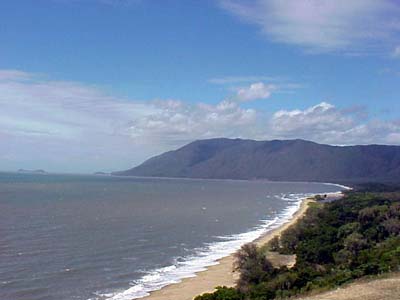 |
| Some years ago there was a very unpopular Politician
hereabouts by the name of Martin Tenni. Someone has spent
a great deal of time and effort going round to every
thing that Tenni ever opened or dedicated or whatever and
obliterated his name. Whilst I don't really approve of
vandalism, I didn't like Tenni either and can understand
the sentiment that drives whoever did this.
|
 |
| Here we are just arriving at Port Douglas. Nobody had
ever heard of Port Douglas until and Australian developer
(and now resident of Spain) Christopher Skase selected it
as the site of one of the most stupendous integrated resorts ever built, the Port Douglas Mirage Resort. Urban
legend has it that Chris found the drive into Port
Douglas a little boring and a bit of an eyesore so he
purchased the entire stock of an oil palm plantation and
relocated the palms to line the road into the town.
Legend also has it that he paid the plantation owner $A1,000
per tree.
If this is even remotely true the former plantation
owner won early retirement as I have counted in excess of
300 of them on just the main road alone.
|
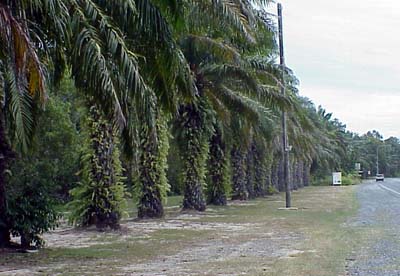 |
| My good friend Henry Griggs, who is living in the USA
at present writes to me often regarding an Australian
theme eating establishment he frequents. The story of the
crassness of the place has had me inwardly cringing many
times. Such things as "Rockhampton stew" or
"Bindee Grass salad" do not actually exist. Then
I found this place in Port Douglas........
Every single possible Australian cliche at one big
location. Chemically aged corrugated iron, hewn timber
furniture put together with modern glues and fasteners
and a menu that includes crocodiles, koala bears, possums
and kangaroo.
The rest of Port Douglas is vibrant and modern, this
monstrosity sticks out like a sore thumb.
May they go broke quickly!
|
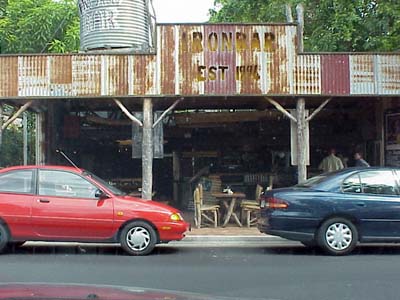 |
| This small picture doesn't do this place justice. For
many years this house on the outskirts of Mossman has
been a "must stop". The man who owns it is in
to wind toys in a big, big way. Big ones, little ones,
slow ones, fast ones, you name it, he has it.....
The other thing that a still photo doesn't do is
convey the noise they make.
If I was this guy's neighbour I would have murder in
mind.
|
 |
| This curtain Fig is found on the Atherton tableland
near the township of Yungaburra (home of the Burra Inn,
the best value eatery on planet Earth). The story goes
that long, long ago a strangler fig started growing
around a host tree which died and then fell over under
the weight of the Fig.
The Fig just kept growing, forming the curtain you see
here.
|
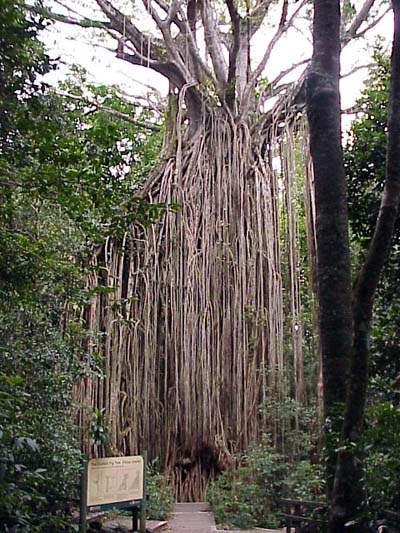 |
| The Australian sugar museum at Innisfail contains
many interesting exhibits, amongst them are a number of
early farm tractors, one of the first mechanised cane
harvesters, the world's only remaining complete "Patent
Drive" locomotive and an impressive collection of
"sugar chemistry" tools (my mother was once a
sugar chemist, hence the interest). It also has a
Furphy water cart.
In two world wars Australian troops went to the front
accompanied by Furphy Farm Water Carts.
As the water cart driver was frequently the most
travelled (non-com) person on the battlefield he
inevitably became the carrier of messages, news,
information and gossip,
Hence the Australian expression "it might be a
bit of a Furphy" for anything that sounds a bit too
fantastic to be true.
The Furphy was made of cast iron end plates fixed to a
cylindrical steel centre section to form a tank. Until
this one I have never seen a complete one, only the end
plates seem to have survived in the main.
|
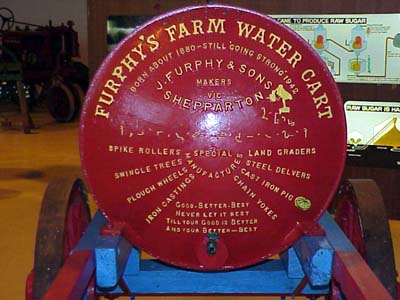 |
| Bugger it, I'm so impressed by the Furphy, here
another photo of it! |
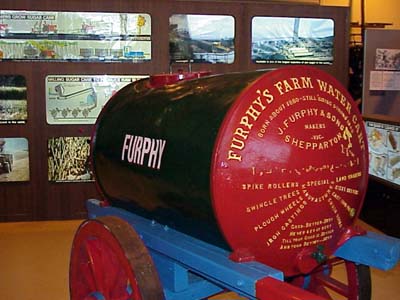 |
OK. Here's the usual:-